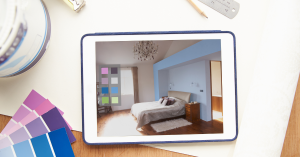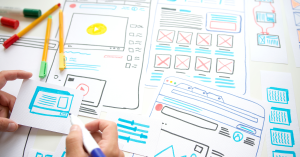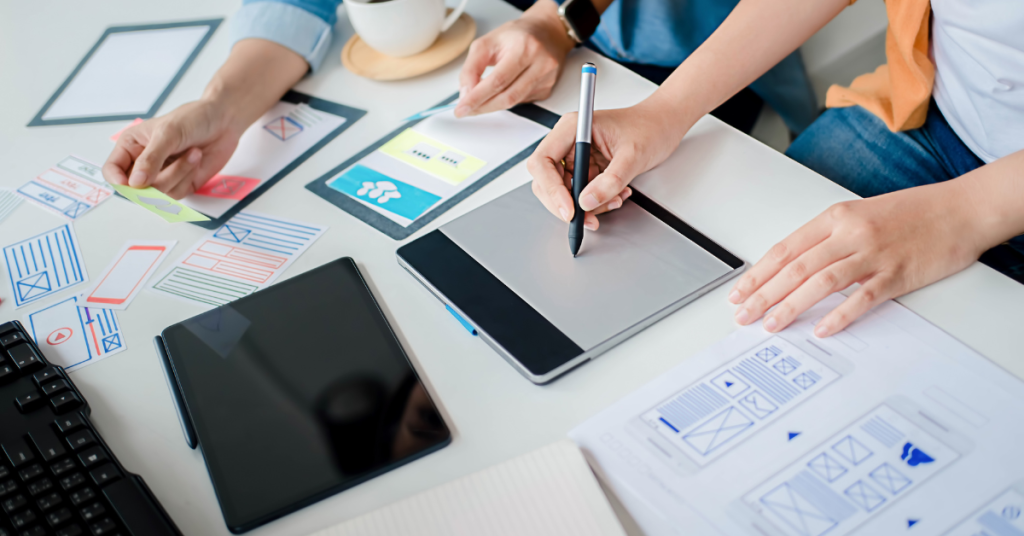In today’s digital landscape, a Creative Website Design Ideas serves as the virtual storefront for businesses and individuals alike. A well-designed website not only attracts visitors but also keeps them engaged and coming back for more. In this article, we will explore 10 creative website design ideas that will inspire your next project. From minimalist layouts to interactive elements, we’ll delve into techniques and strategies to elevate your website’s aesthetics and functionality. Whether you’re a seasoned designer or just starting out, these ideas will spark your creativity and help you craft a standout online presence. Let’s dive in and discover how to make your website truly unforgettable.
Minimalist Design: Less is More in Modern Web Design

In recent years, minimalist design has emerged as a dominant trend in web design, prioritizing simplicity, clarity, and functionality. This approach focuses on stripping away unnecessary elements and clutter, leaving behind a clean and elegant aesthetic that enhances the user experience. Here’s a detailed exploration of minimalist design principles and how to implement them effectively:
- Understanding Minimalism: Minimalist design is rooted in the principle of “less is more.” It emphasizes the importance of removing distractions and focusing on essential elements to convey information effectively. By eliminating unnecessary embellishments, minimalist websites achieve a sense of sophistication and refinement.
- Whitespace Utilization: Also known as negative space, whitespace plays a crucial role in minimalist design. It provides visual breathing room between elements, allowing content to stand out and users to navigate with ease. Proper utilization of whitespace creates a sense of balance and harmony, enhancing overall readability and usability.
- Simplified Layouts: Minimalist websites often feature clean and straightforward layouts, with a clear hierarchy of content. Key elements such as navigation menus, headers, and calls-to-action are strategically placed to guide users through the site seamlessly. By streamlining the layout, designers can focus attention on the most important elements and enhance user engagement.
- Limited Color Palette: Minimalist design typically employs a limited color palette, consisting of neutral tones and subtle accents. This restrained approach to color helps create a cohesive visual identity and ensures that the focus remains on the content itself. By avoiding excessive use of color, minimalist websites achieve a timeless and elegant aesthetic.
- Typography Choices: Typography plays a significant role in minimalist design, with a focus on readability and simplicity. Sans-serif fonts are commonly used for their clean and modern appearance, while serif fonts may be employed for added sophistication in certain contexts. Designers carefully select fonts and typography styles to complement the overall aesthetic of the website.
- Emphasis on Content: In minimalist design, content takes center stage. Whether it’s text, images, or multimedia elements, content is presented in a clear and uncluttered manner, allowing it to shine without distractions. By prioritizing content over decorative elements, minimalist websites deliver a more focused and impactful user experience.
- Mobile Responsiveness: Minimalist design lends itself well to responsive web design, ensuring a seamless experience across devices of all sizes. By prioritizing simplicity and clarity, minimalist websites adapt gracefully to various screen sizes and orientations, maintaining their effectiveness and usability on smartphones, tablets, and desktops alike.
Interactive Elements: Engaging Users with Dynamic Features
In the ever-evolving landscape of web design, interactive elements have become essential for engaging users and enhancing the overall user experience. From animated graphics to interactive menus, these dynamic features add depth and interactivity to websites, captivating visitors and encouraging them to explore further. Let’s delve into the world of interactive elements and explore how they can elevate your website:
Introduction to Creative Website Design Ideas :
Interactive design refers to the integration of elements that respond to user input, such as clicks, taps, or gestures. These elements engage users on a deeper level, encouraging active participation and fostering a sense of connection with the website. From subtle animations to immersive multimedia experiences, interactive design encompasses a wide range of techniques and strategies.
Types of Interactive Elements:
Interactive elements come in various forms, each serving a specific purpose and enhancing different aspects of the user experience. Common examples include:
- Hover Effects: Interactive hover effects provide visual feedback when users hover their cursor over clickable elements, such as buttons or links. These effects can range from simple color changes to more complex animations, adding a layer of interactivity to the user interface.
- Scroll Animations: Scroll animations trigger animations or transitions as users scroll through the webpage, creating a dynamic and engaging browsing experience. These animations can be used to reveal content, showcase products, or add visual interest to the page.
- Sliders and Carousels: Sliders and carousels allow users to interact with multimedia content, such as images or videos, by swiping or clicking through a series of slides. These interactive elements are commonly used to highlight featured products, showcase portfolios, or tell stories in a visually compelling way.
- Interactive Forms: Interactive forms enhance user engagement by providing feedback and guidance as users fill out input fields or submit information. Features such as real-time validation, autocomplete suggestions, and conditional logic can streamline the form-filling process and improve usability.
Benefits of Creative Website Design Ideas :
Incorporating interactive elements into your website offers several benefits:
- Enhanced Engagement: Interactive elements capture users’ attention and encourage them to interact with the website, prolonging their stay and reducing bounce rates.
- Improved Usability: Interactive features can improve the usability of your website by guiding users through complex processes, providing feedback, and facilitating navigation.
- Increased Conversions: Interactive elements can drive conversions by drawing attention to key calls-to-action, promoting product discovery, and creating memorable user experiences that encourage repeat visits.
- Enhanced Brand Perception: Well-designed interactive elements reflect positively on your brand, conveying a sense of innovation, professionalism, and attention to detail.
Best Practices for Interactive Design:
To ensure the effectiveness and usability of interactive elements, consider the following best practices:
- Keep it Intuitive: Interactive elements should be intuitive and easy to use, requiring minimal effort from the user to understand and interact with.
- Maintain Performance: Ensure that interactive elements do not compromise the performance of your website, especially on mobile devices with limited resources.
- Test and Iterate: Conduct usability testing and gather feedback to identify any usability issues or areas for improvement. Iterate on your designs based on user feedback to create the best possible user experience.
Bold Typography: Making a Statement with Fonts

Typography is a fundamental aspect of web design that goes beyond just selecting fonts. It plays a crucial role in conveying tone, establishing hierarchy, and guiding user attention. Bold typography, in particular, offers a powerful way to make a statement and create visual impact on a website. Let’s explore how you can leverage bold typography to enhance your design:
- Choosing the Right Fonts: The first step in utilizing bold typography is selecting the right fonts for your website. Bold fonts come in a variety of styles, from classic serifs to modern sans-serifs and decorative display fonts. Consider the personality and tone you want to convey, as well as the readability and legibility of the fonts across different devices and screen sizes.
- Establishing Hierarchy: Bold typography can help establish hierarchy and structure within your content, making it easier for users to navigate and digest information. Use larger, bolder fonts for headlines and titles to grab attention and create focal points, while employing smaller, lighter fonts for body text and secondary content to maintain readability and balance.
- Creating Contrast: Bold typography creates contrast against other elements on the page, such as images, backgrounds, and whitespace. This contrast draws attention to important content and helps guide users’ eyes through the page. Experiment with different font weights, sizes, and colors to create visual interest and enhance readability.
- Emphasizing Key Messages: Bold typography is an effective way to emphasize key messages, calls-to-action, and important information on your website. Use bold fonts to highlight quotes, statistics, or key selling points that you want to stand out and capture users’ attention. Incorporate strategic use of color, typography, and layout to reinforce the importance of these messages.
- Maintaining Readability: While bold typography can make a statement, it’s essential to ensure that your text remains readable and accessible to all users. Avoid using overly decorative or stylized fonts that may sacrifice readability for visual impact. Pay attention to factors such as line spacing, line length, and contrast to optimize readability and legibility across devices.
- Consistency and Cohesion: Maintain consistency in your typography choices throughout your website to create a cohesive and unified design. Use a limited number of fonts and font weights to establish a visual hierarchy and avoid overwhelming users with too many different styles. Consistent typography reinforces your brand identity and improves overall user experience.
- Responsive Typography: Ensure that your bold typography remains effective and visually appealing across different devices and screen sizes. Use responsive typography techniques, such as fluid typography and media queries, to adjust font sizes and layouts based on viewport size and device capabilities. Test your typography across various devices and screen resolutions to ensure optimal readability and visual impact.
Visual Storytelling: Using Images and Videos to Convey Messages
In today’s digital age, visual storytelling has become a powerful tool for capturing attention, evoking emotions, and conveying complex messages in a compelling and memorable way. Through the strategic use of images, videos, and multimedia content, web designers can create immersive experiences that resonate with users on a deep and personal level. Let’s explore the art of visual storytelling and how you can harness its power to enhance your website:
- The Power of Visuals: Visual content has a profound impact on human cognition and perception. Studies have shown that the human brain processes images much faster than text, and visuals are more likely to be remembered and shared by users. By incorporating visuals into your website, you can communicate ideas and evoke emotions more effectively than with text alone.
- Choosing the Right Visuals: When selecting images and videos for your website, it’s essential to choose visuals that align with your brand identity, message, and target audience. Consider the tone and mood you want to convey, as well as the specific emotions or reactions you want to elicit from users. High-quality, relevant visuals can enhance the overall user experience and reinforce your brand’s credibility and authenticity.
- Telling a Story: Visual storytelling is about more than just showcasing pretty pictures. It’s about weaving a narrative that engages users and draws them into your world. Whether you’re telling the story of your brand, showcasing your products or services, or sharing customer testimonials and success stories, use visuals to create a cohesive and compelling narrative that resonates with your audience.
- Creating Emotional Connections: Visuals have the power to evoke emotions and create lasting impressions on users. Use images and videos to tap into your audience’s emotions, whether it’s joy, excitement, nostalgia, or empathy. By connecting with users on an emotional level, you can build trust, foster loyalty, and encourage engagement with your brand.
- Enhancing User Experience: Visual storytelling can significantly enhance the user experience by making content more engaging, memorable, and easy to understand. Use visuals to break up long blocks of text, illustrate complex concepts, and guide users through your website’s navigation. Interactive multimedia elements, such as videos, slideshows, and galleries, can further enrich the user experience and encourage exploration.
- Optimizing for Performance: While visual content can enhance your website’s aesthetics and user experience, it’s essential to consider the impact on performance. Optimize images and videos for web use by compressing files, resizing dimensions, and using modern image formats such as WebP. Implement lazy loading and other performance optimization techniques to ensure fast load times and smooth browsing experiences for users.
- Accessibility Considerations: Ensure that your visual content is accessible to all users, including those with disabilities. Provide alternative text (alt text) for images and captions or transcripts for videos to make your content accessible to screen readers and assistive technologies. Consider color contrast, font sizes, and other accessibility best practices to ensure that all users can engage with your visual content.
Unique Navigation: Enhancing User Experience with Creative Menus
Navigation is a critical component of web design, serving as the roadmap that guides users through your website’s content and functionality. While traditional navigation menus serve their purpose, incorporating unique and creative navigation elements can elevate the user experience and set your website apart from the competition. Let’s explore how you can enhance user experience with creative menus:
- Introduction to Creative Navigation: Creative navigation refers to the use of unconventional or innovative menu designs to enhance user engagement and streamline navigation. Instead of relying solely on standard horizontal or vertical menus, creative navigation elements can include sidebars, mega-menus, sticky menus, hidden menus, and more. These unique designs not only catch users’ attention but also make navigation more intuitive and enjoyable.
- User-Centric Design: When designing your website’s navigation, it’s essential to prioritize the needs and preferences of your users. Consider the goals and tasks that users are likely to perform on your site, as well as their browsing habits and expectations. Tailor your navigation structure and design to facilitate easy access to the most relevant and important content, minimizing the need for users to dig through multiple layers of menus.
- Enhanced Visual Appeal: Creative navigation menus offer an opportunity to inject personality and visual appeal into your website design. Whether it’s through custom animations, unique transitions, or eye-catching graphics, creative navigation elements can make a strong visual statement and leave a memorable impression on users. Choose designs and effects that complement your brand identity and enhance the overall aesthetic of your website.
- Improved Accessibility: While creativity is essential in designing navigation menus, it’s crucial to ensure that they remain accessible to all users, including those with disabilities. Pay attention to factors such as color contrast, font sizes, keyboard accessibility, and screen reader compatibility to ensure that your navigation menus are usable by everyone. Provide clear labels and intuitive navigation paths to help users navigate your site efficiently.
- Mobile-Friendly Navigation: With an increasing number of users accessing websites on mobile devices, it’s essential to prioritize mobile-friendly navigation designs. Consider implementing responsive navigation menus that adapt gracefully to different screen sizes and orientations. Use techniques such as collapsible menus, off-canvas navigation, and touch-friendly gestures to provide a seamless navigation experience on smartphones and tablets.
- Enhanced Functionality: Creative navigation menus can also offer enhanced functionality beyond simple navigation. Consider integrating features such as search functionality, filters, sorting options, and interactive elements directly into your navigation menus to streamline user interactions and improve usability. By providing users with quick access to relevant content and tools, you can enhance their overall browsing experience and increase engagement on your site.
- Testing and Iteration: As with any aspect of web design, it’s essential to test your navigation menus thoroughly and gather feedback from users to identify any usability issues or areas for improvement. Conduct usability testing sessions with representative users to evaluate the effectiveness and usability of your navigation designs. Iterate on your designs based on user feedback to create navigation menus that are intuitive, efficient, and user-friendly.
Color Psychology: Harnessing the Power of Color in Design

Color is a fundamental element of design that influences mood, perception, and user behavior. By understanding the principles of color psychology, web designers can harness the power of color to evoke specific emotions, communicate messages, and create visually appealing websites. Let’s explore how you can leverage color psychology to enhance your website design:
Understanding Color Psychology:
Color psychology is the study of how colors affect human emotions, attitudes, and behaviors. Different colors evoke different psychological responses, which can vary based on cultural, personal, and contextual factors. By understanding the meanings and associations of various colors, designers can strategically use color to create desired effects and influence user perceptions.
Color Meanings and Associations:
Each color carries its own unique meanings and associations, which can evoke specific emotions and convey particular messages. For example:
- Red: Often associated with passion, excitement, and urgency, red can evoke strong emotions and encourage action.
- Blue: Symbolizing trust, calmness, and professionalism, blue is commonly used in corporate and business contexts.
- Yellow: Representing warmth, optimism, and creativity, yellow can evoke feelings of happiness and positivity.
- Green: Associated with nature, growth, and harmony, green conveys a sense of balance and tranquility.
- Purple: Symbolizing luxury, creativity, and spirituality, purple is often used to evoke a sense of sophistication and elegance.
- Orange: Combining the energy of red with the optimism of yellow, orange is vibrant and attention-grabbing, often used to convey enthusiasm and excitement.
- Black: Signifying power, elegance, and sophistication, black adds a sense of drama and authority to design.
- White: Symbolizing purity, simplicity, and cleanliness, white creates a sense of space and freshness.
Creating Emotional Connections:
By selecting colors that resonate with your brand identity and target audience, you can create emotional connections and evoke specific feelings and associations. Consider the emotions you want to evoke and the messages you want to communicate through your website, and choose colors that support those objectives. Whether you’re aiming for excitement, trust, calmness, or creativity, color can help you achieve your desired emotional response.
Color Harmony and Contrast:
In addition to selecting individual colors, it’s essential to consider color harmony and contrast in your design. Harmonious color schemes, such as complementary, analogous, or monochromatic palettes, create a sense of cohesion and balance in your design. Contrast, on the other hand, can help draw attention to key elements and create visual interest. Experiment with different color combinations and contrast levels to find the perfect balance for your website.
Accessibility Considerations:
While color can enhance the visual appeal and emotional impact of your website, it’s crucial to ensure that your color choices are accessible to all users, including those with color vision deficiencies. Avoid relying solely on color to convey information or distinguish between elements. Use other visual cues, such as icons, patterns, or text labels, to supplement color information and improve accessibility for all users.
Testing and Iteration:
As with any aspect of web design, it’s essential to test your color choices and gather feedback from users to ensure their effectiveness and appropriateness. Conduct usability testing sessions with representative users to evaluate how different color schemes and combinations are perceived and how they impact user experience. Iterate on your designs based on user feedback to create visually appealing and emotionally resonant color schemes that enhance your website’s overall impact.
Creative Website Design Ideas Conclusion
In conclusion, the art of web design encompasses a myriad of elements, each playing a crucial role in shaping the user experience and communicating the essence of a brand or message.
From minimalist layouts to bold typography, interactive elements to visual storytelling, and creative navigation to strategic color choices, every aspect contributes to the overall impact and effectiveness of a website.
By embracing innovative techniques and leveraging psychological principles, designers can create immersive and memorable experiences that captivate audiences, foster emotional connections, and drive engagement.
Whether you’re designing a personal blog, an e-commerce platform, or a corporate website, the principles outlined in this article offer valuable insights and strategies for crafting exceptional web experiences that leave a lasting impression on visitors.
As the digital landscape continues to evolve, embracing creativity, experimentation, and user-centric design will be key to staying ahead and delivering meaningful experiences that resonate with audiences worldwide.
FAQs (Frequently Asked Questions) Creative Website Design Ideas
1. Why is web design important?
- Web design is crucial as it directly impacts user experience, brand perception, and overall effectiveness of a website. A well-designed website enhances usability, fosters engagement, and communicates messages effectively to the target audience.
2. How can minimalist design benefit my website?
- Minimalist design focuses on simplicity and clarity, allowing content to shine without distractions. It improves readability, enhances user experience, and creates a modern, sophisticated aesthetic that resonates with users.
3. What are some examples of interactive elements in web design?
- Interactive elements include hover effects, scroll animations, sliders/carousels, interactive forms, and more. These features engage users, encourage interaction, and create immersive experiences that keep visitors engaged and entertained.
4. How can I choose the right color scheme for my website?
- Consider your brand identity, target audience, and emotional response you want to evoke. Use color psychology principles to select colors that align with your brand personality and resonate with your audience.
5. What are some best practices for creating accessible web designs?
- Ensure color contrast, provide alternative text for images, use descriptive links, and make sure your website is navigable using keyboard controls. Prioritize accessibility to ensure that all users, including those with disabilities, can access and navigate your website effectively.
6. Why is it important to test and iterate on Creative Website Design Ideas choices?
- Testing allows you to gather feedback from users and identify any usability issues or areas for improvement. Iterating on your designs based on user feedback helps create a more user-friendly, engaging, and effective website.
7. How can I ensure my website’s navigation is intuitive and user-friendly?
- Prioritize user-centric design by considering user goals, minimizing cognitive load, and providing clear, organized navigation paths. Test your navigation with real users to ensure it is intuitive and easy to use across different devices and screen sizes.



